Performance
In our performance tests, we checked out
the speed of our LGA1155 platform with different dual-channel 32GB memory kits
from G.Skill. Each set was tested in two modes: 1) automatic configuring when
every timing is set by the mainboard’s BIOS according to the XMP data or official
specifications (for Ares F3-1333C9Q-32GAO, which does not support XMP) and 2)
with highest clock rate and best timings (as obtained in the above overclocking
tests) set up manually in the mainboard’s BIOS.
First, we want to run synthetic benchmarks
of memory bandwidth and latency. We will use two tools for that. One is the
memory test from SiSoft Sandra 2013. Using a multithreaded Stream algorithm, it
is perfectly suited to modern memory controllers optimized for multi-core CPUs.
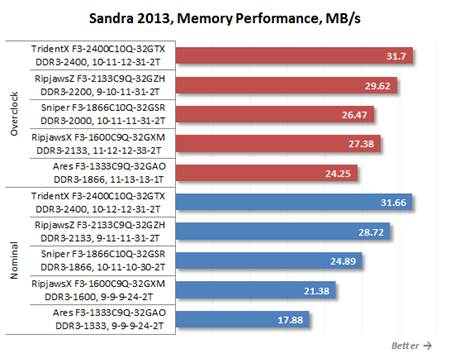
Memory
Performance test from SiSoft Sandra 2013
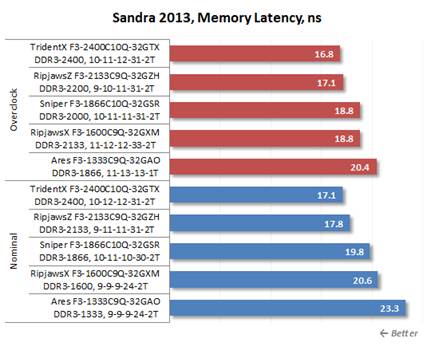
Memory
Latency test from Sandra 2013
And the other is the integrated test from
the ASUS MemTweakIt utility which issues a single number indicative of the
overall memory subsystem performance.

Integrated
test from the ASUS MemTweakIt
The clock rate of the DDR3 SDRAM has a rather
strong influence on the performance of the memory subsystem in platforms with
Ivy Bridge CPUs. For example, increasing that clock rate to 333 MHz helps to
improve the practical memory bandwidth by 10-20% and reduces latency down to
5-15%. It is both of the frequency and timings that impact on the latency when
bandwidth does not depend much on timings.
We can also note that four 8GB memory
modules turn out to be no worse than two DDR3 SDRAM modules in terms of the practical
performance of the memory subsystem. We can see this easily by using the test
data from our previous tests. For example, the DDR3-2400 memory kit Corsair
Dominator Platinum CMD16GX3M2A2400C10 (containing two 8GB modules and with
timings of 10-12-12-31) had a bandwidth of 31.21 GB/s and a latency of 16.8 ns in
Sandra 2013, even worse than the results of the G.Skill TridentX
F3-2400C10Q-32GTX kit which has the same specs but contains four 8GB modules.
The results of SiSoft Sandra 2013 and ASUS
MemTweakIt! Suggest that it makes practical sense to be particular about
selecting DDR3 SDRAM modules. However, there are artificial standards to
measure how fast the CPU can operate with system memory. Every day, applications
are not so memory-sensitive, yet we want to check them out as well.

Cinebench
11.5, Rendering
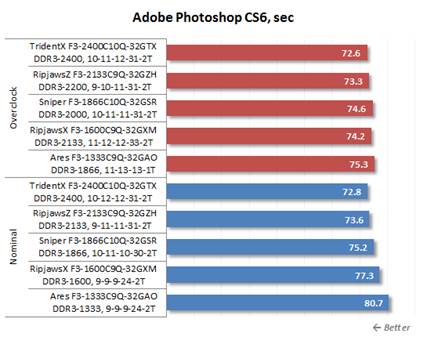
Adobe
Photoshop CS6
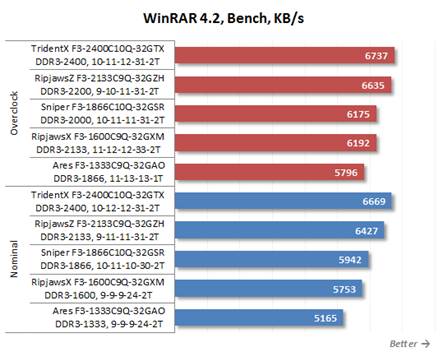
WinRAR
4.2

x264
FHD Benchmark
Fast overclocker memory is indeed appropriate
in some cases, especially if it is the same price as the regular mainstream
memory. Memory subsystem parameters can affect the speed of gaming
applications, for example.
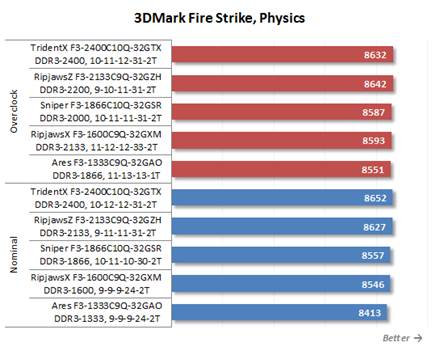
3Dmark
Fire Strike

Crysis
WARHEAD, 1280x800 UHQ
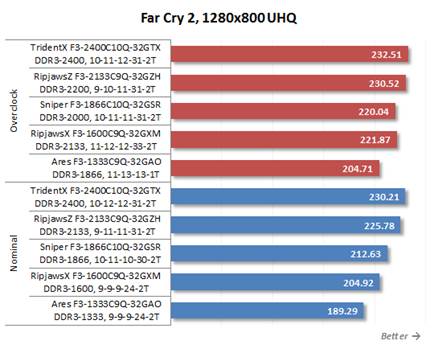
Far
Cry, 1280x800 UHQ
Of course, it is the graphics subsystem that
mostly affects the frame rate, but the memory frequency is a factor as well.
Fast memory can help you improve performance by a few percent. Thus, again, the
choice of DDR3 SDRAM quite important and the key parameter to consider in this
case is the frequency of DDR3 SDRAM.
As for the sheer ability provided by these
32 GB memory kits, it does not provide any benefits in terms of speed. Every day,
computing tasks do not require so much memory, but it may come in handy in special
cases, such as is you process large high-resolution images or use virtual
devices. On the other hand, there is no reason why you should not allow
yourself by purchasing more system memory for the future, just in case,
especially as the products discussed here will only cost you $ 200 - 300.
Conclusion
Although we have only tested products from
G.Skill in this review, we are able to make a far more general conclusion. We
have made sure that today’s dual-channel memory controllers integrated into Ivy
Bridge CPUs can easily operate with four-module DDR3 SDRAM configurations, with
two modules per channel. There are no performance or compatibility issues. You
can use four modules in the same operation mode as well as you would use two.
Therefore, high-capacity four-piece DDR3
SDRAM memory kits designed for Ivy Bridge platforms are very appealing to
enthusiasts. On the other hand, it's good to have more memory, especially when
it comes at such a low price as today. Therefore, if you desire to have a progressive
computer configuration, you may want to seriously consider a 32GB memory kit of
four 8 GB modules.
Especially for G.Skill, this memory
manufacturer currently offers the broadest selection of such kits of all (for
the platforms with four DIMM slots). Most of the available G.Skill has highly
attractive specs. And I'm not just talking about the frequencies and timings,
which can vary in a wide range and go as high as DDR3-2400. G.Skill also offers
high-quality chips and PCBs with good lineage.
Talking about the specific products we have
tested today, we want to separate two of them. First, it is the G.Skill
RipjawsX F3-1600C9Q-32GXM kit which rated for DDR3-1600 but has an impressive
high overclocking potential. Most importantly, it is one of the most reasonably
32GB memory kits available today.

The
G.Skill RipjawsX F3-1600C9Q-32GXM kit with its impressive high overclocking
potential
And secondly, the G.Skill TridentX F3-2400C10Q-32GTX
has excellent nominal specifications and can work as DDR3-2400 with CAS Latency
= 10. However, the key feature is its unique design of the heat-spreaders,
which can be tall and pretty or can quickly transformed into low-profile ones to
ensure compatibility with any CPU cooler.
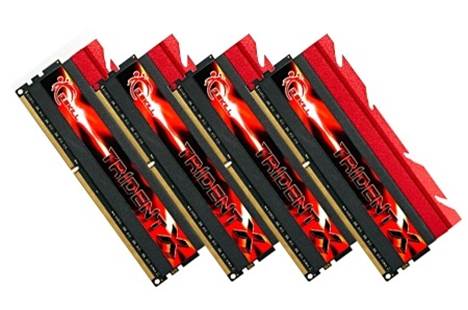
The
G.Skill TridentX F3-2400C10Q-32GTX with its excellent nominal specs